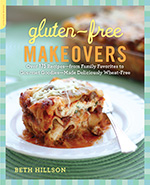Using Your Noodle
I’ve always had a love affair with pasta salads. Easily transformed, they take on the flavor of the dressing, the add-ins, the seasonings, the spices. Cilantro, black beans, corn, and pico de gallo allow me to call my salad, “Mexican Fiesta.” Adding chopped pepperoni, black olives, mozzarella cheese, and artichoke hearts turns my dish into “Antipasto Pasta.”
What’s more, I make it up as I go along. If I have feta cheese and Greek dressing that’s gluten free, the salad might be more of a “Greek Goddess” salad. Caesar dressing and anchovies might become my “Hail Caesar Pasta Salad.” You get the picture. Pasta salad is easy, versatile, and delicious. And little tweaks can completely change its ethnic roots.
Perfect Pasta
With all the gluten-free pasta products available, the trick is selecting the best cut for your salad and following a few simple tips to keep the noodles from getting mushy or absorbing all the dressing before it’s served.
For most pasta salads, select a short pasta. Spirals (fussili), elbows, cavatelli, and small shells are great choices as they hold their shape and pull the flavors of the salad into the crevices of the noodles.
Undercook pasta by 3 to 4 minutes or just until the brittleness is gone. It should be chewy, but not crunchy. Drain the pasta and rinse well under cold water. This removes the starch and cools the pasta so that it does not continue cooking. Now the pasta can sit while you prepare the added ingredients.
Pasta salads can be prepared a few hours ahead but don’t toss the ingredients and dressing into the salad until just before serving.
All Grains are Not Created Equal
Gluten-free pasta comes in all matter of grains. Quinoa, corn, rice, and brown rice are the most common. And many are a blend of flours as well. White rice and brown rice pasta do not hold up as well as others. You might want to leave these for hot dishes that are served as soon as they are made. Corn pasta (preferably from Italy) and quinoa pasta are well suited to pasta salads. They do not fall apart or turn mushy and can even stay overnight in the refrigerator without decomposing.
Here’s one of my favorite summer pasta salads. Roasting the vegetables before they are added, produces an intense and vibrant flavor that is both fresh and satisfying.
Quinoa Pasta Salad with Roasted Tomatoes, Orange and Olives
1 (8-ounce) box Ancient Harvest quinoa rotelle pasta (about 2 cups) or other quinoa or corn pasta
6 large plum tomatoes, each cut into 6 to 8 wedges
1 large onion, halved lengthwise, cut into thin wedges
2 tablespoons extra-virgin olive oil
4 cloves garlic, coarsely chopped
Juice and zest of one orange rind, divided
Salt and freshly ground pepper, to taste
Fresh basil, cut into thin strips (about ¼ cup)
½ cup halved, pitted Kalamata olives
½ cup fresh feta cheese crumbles or dairy-free cheese shreds 2 tablespoons orange juice
1 tablespoon olive oil
Cook pasta in a large pot of boiling salted water 6 to 7 minutes or until tender but still firm to bite. Rinse in cool water and drain well. Set aside.
Preheat oven to 450°F. Oil 2 rimmed baking sheets with nonstick spray.
Spread tomato wedges on one sheet and onion wedges on the second sheet.
Combine 2 tablespoons olive oil, garlic and juice and rind of one orange. Drizzle half over vegetables on each sheet. Sprinkle with salt and pepper. Roast in preheated oven until vegetables are very tender and brown around edges, stirring occasionally, about 30 minutes for onions and 45 minutes for tomatoes. Cool slightly. Set aside.
Transfer pasta to a large serving bowl. Add roasted tomato and onion mixtures, basil and olives to pasta. Stir gently. Add cheese, 2 tablespoons orange juice and olive oil. Toss. Add more salt and pepper, to taste.
Categories: Recipes | Tags: gluten free, Memorial Day recipes, Pasta, Pasta Salad, pasta salad recipes, recipes | 4 Comments »








 Baking guru,
Baking guru,
Rita Horn says:
May 25, 2012 at 2:13 pm /
I too prefer the corn and quinoa pasta, because mushy pasta is a disappointment. Besides, quinoa has much more nutritional value as well as texture. However I’ve actually noticed that overnight, such pastas actually firm up and taste undercooked when eaten the next day. I find they need some liquid added when reheated, which reconstitutes them to their former texture. Perhaps when eating cold pasta the next day it might be wise to add a small amount of liquid and let it stand an hour. I’ll try it this summer, because I’ve had pasta salad get too firm overnight.
This sounds like a great meal!
Beth Hillson says:
May 26, 2012 at 11:21 pm /
Hi Rita,
I’ve had the best luck with corn and quinoa pasta holding up overnight. But, if the pasta is too firm after standing overnight, by all means, add a tiny bit more dressing. Hot dishes are certainly more of a challenge. Your tips are great – – tips we may all want to try. Thanks. Beth
Jason says:
June 27, 2012 at 6:05 pm /
“Pasta salads can be prepared a few hours ahead but don’t toss the ingredients and dressing into the salad until just before serving.”
– this explains why by the end of a long barbecue the salad I’ve brought is one giant unappetizing lump. I figured maybe I needed to stir as the day wore on, but now I’ll have to bring the dressing and mix it in once I arrive. Thanks!
Beth Hillson says:
June 28, 2012 at 9:34 pm /
Great idea to dress the salad when you arrive at the picnic. I’ll keep that one in mind. Thanks for that tips. Beth